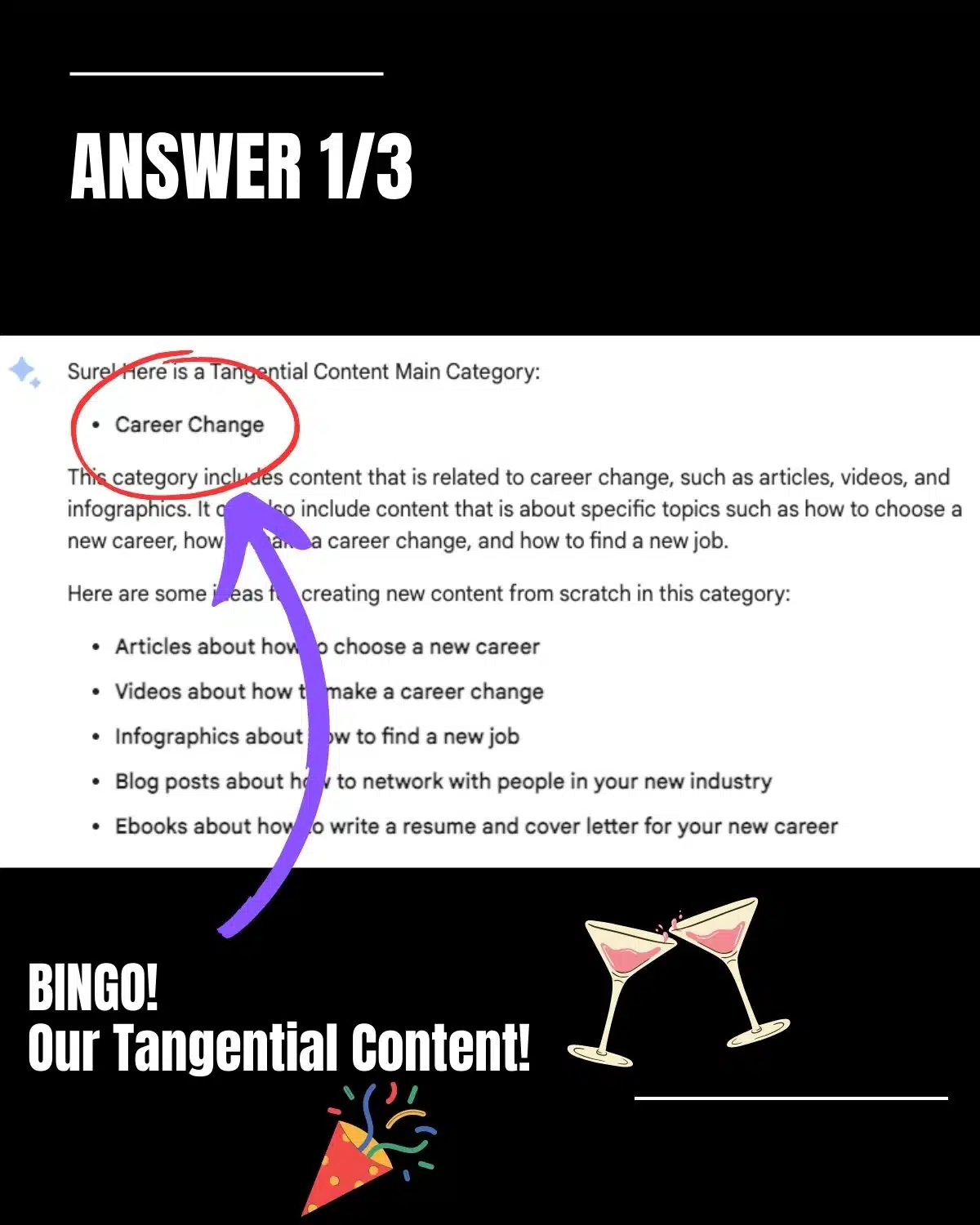How to use Google Bard to find content ideas fast
[ad_1]
When your industry is over-saturated, chances for ranking higher on search engines become harder.
SEO tools give you keywords variations of your main keyword. But in order to attract new users, you need new keywords that people search while, at the same time, none of your competitors is targeting.
The challenge is this: how do you find these new keywords no tool can provide and no competitor is ranking for?
That’s when tangential SEO can come to help.
This is a strategy designed to increase your visibility on search engines for keywords that are not your core business but are still relevant to your audience.
What are the benefits of tangential SEO?
One of the main benefits of tangential SEO is attracting a wider audience compared to targeting traditional business keywords.

Another benefit of tangential SEO is exponentially increasing the number of topics you can write about. Potentially, with this strategy, your content can scale because you don’t run out of content ideas.
When it comes to SEO performance, when you cover a range of topics, you can rank for more keywords, which means you’ll attract more traffic to your website.
Last but not least, tangential content ideas could increase your backlinks efforts.
When you publish about trending topics around your industry, chances are your posts can passively attract new backlinks.
Let’s see a couple of examples of tangential topics.
- Main topic: Holiday home.
- People looking to buy homes for holidays only. Companies operating in this niche could create topics around real estate investments and sub-letting opportunities because holiday homeowners could use these houses to earn money on the side.
- Main topic: Online courses.
- Brands operating in this industry could talk about jobs you can do without a degree because students looking to buy courses online will likely avoid university. Here is an example of this content about jobs without a degree. The brand can also focus on career change topics and content, start to showcase job opportunities and create a job board.
The good news is that every niche can use tangential content. Here are more examples from various niches:
| Niche | Tangential Topic |
| Travel | Cinema |
| B2B Marketing | Travel |
| Banking | Technology |
| Fitness | Covid-19 |
| Education | Employment |
| CRM | Remote work |
| Healthcare | Data analysis |
| Tech | Productivity |
Tangential SEO starts from one niche and can be extended to various niches, which also means that your research will uncover new angles and perspectives you might not have noticed before.
You’ll become familiar with your customer’s expectations, pain points and motivations.
When you research the topics they like to read about, you also learn more about your industry, making you a real expert in audience research.
Get the daily newsletter search marketers rely on.
Why do you need to use AI for tangential SEO?
If it sounds like a lot of work, it’s because it is.
Tangential SEO requires a huge amount of users and industry research simply because no SEO tool can provide you with this data collection process.
The traditional method of building tangential SEO could be time-consuming. This involves some of the following steps:
A lot of preparation is involved before you can write a line of copy.
But there is a quicker way, thanks to AI. In this case, I used Google Bard to develop new, tangential content ideas based on my audience research.
This method could work because it essentially automates the above steps. The secret is to write the right prompt for training AI to your bespoke results.
Essentially, we can reduce the number of steps from six to simply two:
- Write and refine your prompts for Bard.
- Feed the machine with your keywords.
Now, it’s time to see this process in detail.
Ready? Let’s go.
Step 1: Write the prompts
Prompts are essentially instructions you give to AI in the form of text, question, information or code that communicates to AI the reply you want to get.
Writing great prompts allows you to work better with AI tools and generate relevant results instead of mediocre ones.
Good prompts can increase efficiency because you spend less time refining your instructions, and they also strengthen AI responses, providing you with accurate, in-depth and relevant answers.
Because the prompt will be long and detailed, we can split it into three parts to make it more digestible and easier to understand.
Impersonation and context setting
This aims to provide AI with the most accurate information possible.
Feel free to steal my prompts and generate new tangential ideas in less than two minutes.
- “Act both as a psychologist and a search engine consultant trained in helping people find the right product or service for their needs. You are familiar with the concept of tangential SEO when evaluating common reasons for making a choice.”
Now let’s break this first part of the prompt into further analysis to understand what I asked AI to do.
- “Act as a psychologist…”
This first sentence helps Bard behave as a psychologist and sets up the context in which we will operate from now on.
You can instruct Bard (or any AI tool in general) to act as different entities or engage in various situations or tasks.
You can prompt AI to impersonate characters, professionals, or even fictional creatures by providing specific instructions.
- “…trained in helping people find the right product or service for their needs”.
This part of the sentence opens up the AI attitude in preparation for what comes next.
We are telling AI to become a people’s companion when choosing products or services, a sort of shopping consultant, if you will.
“You are familiar with the concept of tangential content”.
This part ensures that we are referring to tangential SEO, which will ensure AI responses align with what we are trying to achieve.
It also removes any misunderstanding because we don’t want to refine the prompt too often. We are trying to get this right the first time.
Set up your prompt goal
After setting the context and the impersonation, it’s time to provide Bard with instructions on the type of results we expect.
We don’t want results to vary. We want results to be very specific for us to continue our process of creating tangential content ideas.
- “Create a tangential content category”
This sentence gives Bard a clear outcome. We want to create a tangential content category.
You can also decide to create two or more categories, but the more you ask from AI, the less accurate results will be.
Remember, AI has some limitations when it comes to spitting our results, sometimes they stop generating, especially in cases where the response takes too long.
That’s why I’d recommend focusing on one tangential category and then repeating the same process for another content category.
- “Be very accurate with your choice.”
We give Bard the permission to pick a category for us. All we ask is to be very specific about it.
- “Give common reasons why people make this particular choice”.
Remember the psychologist’s impersonation earlier on? That’s why we added it to the prompt. Now it’s time to get a reply from AI like a trained psychologist would do.
Research shows that psychology has influenced research in both consumer and marketing, so what’s the best way of understanding consumers’ behavior?
Support prompts
In this last step of writing the prompt, we will focus on the psychological part of our research.
We need a way to tell AI that its responses must have a psychological basis in order to be viable and accurate. Otherwise, it’s like shooting in the dark.
- “Give a list of explanations on the reasons why you chose this category and how it matches with the main content I’ll provide you with.”
This sentence is important because we need Bard to explain to us the reason for their category choice.
Essentially, we are asking Bard to provide us with review tools, we need to be able to make a judgment call and assess whether this proposed category makes sense.
- Does the tangential category match our typical customer?
- Is the customer looking for this type of topic Bard is producing?
If the answer is yes, then we can be certain that the tangential topics proposed by AI are accurate.
Lastly, we also need to take care of AI making assumptions, so we simply ask the following:
- “Don’t remind me of previous instructions, don’t make any assumptions.”
Step 2: Add your keywords
In the second step, we need to give direction to AI about our core business and keywords.
This part is vital because it will further resolve the problem of accuracy that we are likely to encounter with any AI tool.
In other words, in this step, we will connect the previous instructions with your product and services.
As an example of a prompt, we will use the topic of “online courses” for an organization that provides fitness courses and trains people to become personal trainers.
Here is an example of a prompt including both the keyword and the business description:
- “The keyword is Personal training courses and qualifications. From Level 2 Gym Instructor course to Level 3 Personal Trainer certificate, our courses offer a wide range of level to fit your career. We don’t just offer cookie-cutter qualifications. The combination of online and face-to-face training will give you a competitive edge, preparing you to hit the ground running in your new career.”
In this prompt, we must be specific about how the business differentiates itself from competitors. I’d recommend using either your mission statement or the unique selling proposition.
Put everything together
This is the complete prompt you can copy-paste into Bard, obviously changing the keywords and your business description.
- “Act both as a psychologist and a search engine consultant trained in helping people find the right product or service for their needs. You are familiar with the concept of tangential SEO when evaluating common reasons for making a choice. Create a tangential content category. Be very accurate with your choice. Give common reasons why people make this particular choice. Give a list of explanations on the reasons on the reasons why you choose this particular category and how it matches with the content I provide you. Don’t remind me of previous instructions, don’t apologise, don’t self-reference. Don’t make assumptions. Here is the keyword and business description: [insert your keyword + business content].”

The results
If you did everything right, you should be able to get impressive results from Bard that look like this:

The chat found that one of the tangential categories can be “career change.”
This is a brilliant idea because our ideal customer is usually in the middle of changing careers from desk to fitness. They want to enjoy life at the gym and help their clients reach their fitness goals.
Bard also provides us with ideas around the following:
- Articles about how to choose a new career.
- Videos about how to make a career change.
- Blog posts on how to network with people in your new industry.
- Ebooks and posts on how to prepare your cover letter and CVs for your new career
This is exactly what Tangential SEO is about. It’s content that touches your core business but doesn’t directly mention it.
Bard goes a few steps further to provide us also with a wide variety of SEO tangential categories we might want to consider:

Using AI, especially Bard, can save you so much audience research time because AI is trained with billions of data points. Humans can only scratch the surface of the variety of tangential content.
This doesn’t mean we should rely 100% on AI. Business owners and marketers know their customers better than anyone, which puts us in the position to evaluate AI responses.
In this practical example, I used the business description and mission statement to feed AI with it.
Remember that all businesses can use this same methodology as long as you have a compelling case for being special and can articulate it clearly enough for AI.
Opinions expressed in this article are those of the guest author and not necessarily Search Engine Land. Staff authors are listed here.
[ad_2]
Source link






0 Comments